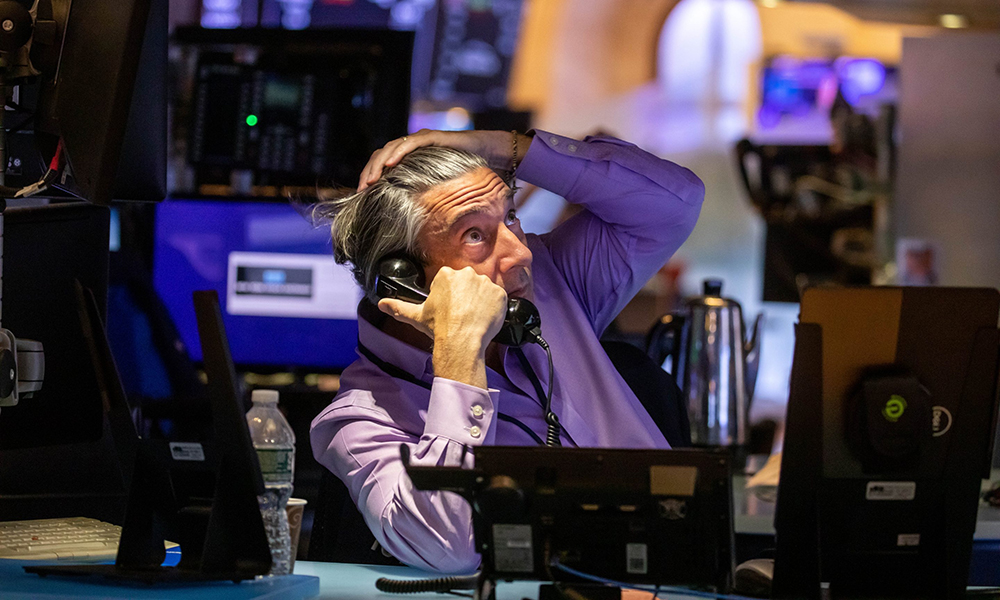
尽管伊朗4月14日向以色列发射了数百枚导弹和无人机,但金融市场对此一片沉默,受此影响,原油和股票期货在次日晚间的交易可谓是平平无奇。
美国主要股指和油价的增幅不到0.2%。西德克萨斯中质原油每桶价格始终未能突破86美元,布伦特原油则来到了90.57美元/桶。分析师早些时候曾预测,布伦特原油每桶价格可能会突破100美元大关,因为在冲突发生之前,其年初至今的价格已经飙升了20%。
黄金作为传统避险资产,价格上涨了o.4%,至每盎司2383美元,但依然低于4月12日的历史新高。
另一种安全资产美国国债遭到小规模抛售,使其10年期收益率上升了1.9个基点,达至4.518%。同样,美元兑欧元和日元的汇率亦有所下滑。
4月13日,加密货币在下滑反弹后再次下探。比特币价格下跌1.3%,至6.54万美元,以太币下滑0.3%,来到3156美元。
最初的沉默反应可能源于人们对于中东冲突不会升级的乐观看法。尽管这是伊朗对以色列开展的首次全面军事行动,但99%的炮弹都被击落,而且并未出现伤亡报告。与此同时,白宫称将努力防止冲突的扩散。据称,拜登总统对以色列总理内塔尼亚胡说,美国不会参与针对伊朗的任何进攻性行动,但此前曾承诺“坚定”支持以色列安全。
凯投宏观(Capital Economics)在4月14日发表的一则纪要中写道,中东紧张局势的升级可能会给美联储放缓降息步伐提供更多的理由,因为原油价格或将干扰这家央行的通胀对抗行动。
凯投宏观首席经济学家尼尔•希林写道:“如今,全球经济的首要风险在于,此事如今是否会升级成更广泛的区域冲突,能源市场又会作何反应。”
但他还表示,潜在的抗衡因素包括中国最近产能扩张所带来的反通货膨胀压力,以及一些欧佩克成员国提升原油产量的需求,前者拉低了出口物品价格,后者会拉低原油价格。
在伊朗发动进攻之后不久,4月13日晚间加密货币价格大幅下跌,但随后又收回了些许失地。市场震荡的早期迹象于此前一日出现,当时,有报道称伊朗不久后将发动攻击,使得美国基准原油价格出现了高达3%的涨幅,达到了87美元/桶。
美国国债也是备受青睐,随着投资者纷纷寻求避险资产,10年期国债收益率出现了高达10个基点的降幅。4月12日美元指数有所回升,原因是地缘紧张局势导致投资者放弃了风险更高的新兴市场货币。
黄金价格达到了新的历史高点,突破每盎司2400美元大关,不过随后又跌破了这一涨幅。股票在4月12日出现了抛售现象,由风险担当科技股引领,因为在投资者看来,有鉴于当前的银行营收以及新通胀数据,美联储短时间内降息的希望十分渺茫。(财富中文网)
译者:冯丰
审校:夏林
尽管伊朗4月14日向以色列发射了数百枚导弹和无人机,但金融市场对此一片沉默,受此影响,原油和股票期货在次日晚间的交易可谓是平平无奇。
美国主要股指和油价的增幅不到0.2%。西德克萨斯中质原油每桶价格始终未能突破86美元,布伦特原油则来到了90.57美元/桶。分析师早些时候曾预测,布伦特原油每桶价格可能会突破100美元大关,因为在冲突发生之前,其年初至今的价格已经飙升了20%。
黄金作为传统避险资产,价格上涨了o.4%,至每盎司2383美元,但依然低于4月12日的历史新高。
另一种安全资产美国国债遭到小规模抛售,使其10年期收益率上升了1.9个基点,达至4.518%。同样,美元兑欧元和日元的汇率亦有所下滑。
4月13日,加密货币在下滑反弹后再次下探。比特币价格下跌1.3%,至6.54万美元,以太币下滑0.3%,来到3156美元。
最初的沉默反应可能源于人们对于中东冲突不会升级的乐观看法。尽管这是伊朗对以色列开展的首次全面军事行动,但99%的炮弹都被击落,而且并未出现伤亡报告。与此同时,白宫称将努力防止冲突的扩散。据称,拜登总统对以色列总理内塔尼亚胡说,美国不会参与针对伊朗的任何进攻性行动,但此前曾承诺“坚定”支持以色列安全。
凯投宏观(Capital Economics)在4月14日发表的一则纪要中写道,中东紧张局势的升级可能会给美联储放缓降息步伐提供更多的理由,因为原油价格或将干扰这家央行的通胀对抗行动。
凯投宏观首席经济学家尼尔•希林写道:“如今,全球经济的首要风险在于,此事如今是否会升级成更广泛的区域冲突,能源市场又会作何反应。”
但他还表示,潜在的抗衡因素包括中国最近产能扩张所带来的反通货膨胀压力,以及一些欧佩克成员国提升原油产量的需求,前者拉低了出口物品价格,后者会拉低原油价格。
在伊朗发动进攻之后不久,4月13日晚间加密货币价格大幅下跌,但随后又收回了些许失地。市场震荡的早期迹象于此前一日出现,当时,有报道称伊朗不久后将发动攻击,使得美国基准原油价格出现了高达3%的涨幅,达到了87美元/桶。
美国国债也是备受青睐,随着投资者纷纷寻求避险资产,10年期国债收益率出现了高达10个基点的降幅。4月12日美元指数有所回升,原因是地缘紧张局势导致投资者放弃了风险更高的新兴市场货币。
黄金价格达到了新的历史高点,突破每盎司2400美元大关,不过随后又跌破了这一涨幅。股票在4月12日出现了抛售现象,由风险担当科技股引领,因为在投资者看来,有鉴于当前的银行营收以及新通胀数据,美联储短时间内降息的希望十分渺茫。(财富中文网)
译者:冯丰
审校:夏林
Oil and stock futures traded largely flat Sunday evening as financial markets offered muted reactions to Iran launching hundreds of missiles and drones at Israel on Saturday.
The major U.S. stock indices and oil prices ticked up less than 0.2%. West Texas Intermediate crude hovered below $86 per barrel, and Brent crude was at $90.57. Analysts had earlier predicted that Brent could spike above $100 per barrel after already surging 20% in the year to date before the attack.
Prices for gold—traditionally seen as another safe-haven asset—edged up 0.4% to $2,383 per ounce, but remain below the record highs touched on Friday.
U. S. Treasury bonds, another safety trade, sold off slightly, lifting the 10-year yield 1.9 basis points to 4.518%. Similarly, the dollar fell against the euro and yen.
Cryptocurrencies dipped after rebounding from losses on Saturday. Bitcoin slipped 1.3% to $65,400, and ether eased 0.3% to $3,156.
The muted initial reaction may be due to optimism that the Middle East conflict won’t escalate. While it marked Iran’s first-ever, full-scale military assault on Israel, 99% of the projectiles were shot down, and no fatalities were reported. Meanwhile, the White House signaled it’s seeking to prevent hostilities from spreading. President Joe Biden reportedly told Prime Minister Benjamin Netanyahu the U.S. would not participate in any offensive action against Iran, after pledging “ironclad” support for Israel’s defense.
Capital Economics said in a note early Sunday that increased tension in the Middle East likely gives the Federal Reserve even more cause to go slow on rate cuts, as oil prices could disrupt the central bank’s battle against inflation.
“The key risks for the global economy are whether this now escalates into a broader regional conflict, and what the response is in energy markets,” wrote Neil Shearing, Capital Economics’ group chief economist
But he added that potential counterweights include disinflationary pressure from China’s recent expansion in production capacity, which has lowered export prices, and demands from some OPEC+ members to pump more crude, which would lower oil prices.
In the immediate aftermath of the Iranian attack, cryptocurrency prices fell sharply Saturday evening but later recouped some losses. Earlier indications of market jitters came on Friday, when reports said an Iranian attack was imminent, boosting U.S. benchmark oil prices as much as 3% to top $87 a barrel.
U.S. Treasury bonds also rallied sharply, sending the 10-year yield down as much as 10 basis points as investors looked for safety. The U.S dollar advanced Friday as the geopolitical tensions caused investors to turn away from riskier emerging-market currencies.
Prices for gold surged to a fresh record high above $2,400 an ounce before later reversing those gains. And stocks sold off on Friday, led by risk-on tech shares, as investors also digested bank earnings and fresh inflation data that further dampened hopes for imminent Fed rate cuts.






